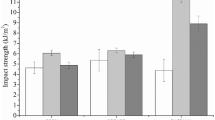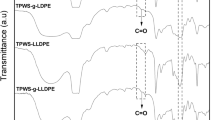Abstract
The property profile of thin thermoplastic starch (TPS)/poly(butylene succinate) (PBS) films was investigated and the potential improvement, which can be achieved due to the utilization of hydrophilic/hydrophobic compatibilizer systems, was assessed. The evaluation in terms of morphology exhibited a very good TPS dispersion (under optimized processing conditions) within the polyester matrix, while an average particle size of 1.5 µm was obtained. Two different raw material approaches were applied for the preparation of the compatibilizers: (a) native corn starch and (b) destructurized TPS. In the course of the compounding process 0.5 and 1.0 wt% of the two compatibilizer systems (a) and (b) were added. In comparison, the addition of the TPS-based compatibilizer resulted in improved incorporation of TPS within the polyester matrix, which was accompanied by higher tensile strength and tear resistance. Explanations for this observation could be that pre-plasticized starch provides a larger reaction surface and enables better homogenization during the course of compounding. In contrast, for native starch the reaction only can take place at the granule surface and thus, the compatibilization was less efficient. The outcome of this investigation is a compostable film material with high bio-based content, which exhibits great potential for single-use, light-weight packaging applications.










Similar content being viewed by others
References
Bastioli C (2001) Global status of the production of biobased packaging materials. Starch 53:368–371
Olivato JB et al (2013) Starch/polyester films: simultaneous optimisation of the properties for the production of biodegradable plastic bags. Polímeros 23:32–36
Wang N et al (2007) Influence of citric acid on the properties of glycerol-plasticized dry starch (DTPS) and DTPS/poly(lactic acid) blends. Starch 59(9):409–417
Kalambur S, Rizvi SSH (2006) An overview of starch-based plastic blends from reactive extrusion. J Plast Film Sheeting 22(1):39–58
Ma P et al (2012) Tailoring the morphology and properties of poly(lactic acid)/poly(ethylene)-co-(vinyl acetate)/starch blends via reactive compatibilization. Polym Int 61(8):1284–1293
Wang N, Yu J, Ma X (2007) Preparation and characterization of thermoplastic starch/PLA blends by one-step reactive extrusion. Polym Int 56(11):1440–1447
Maliger RB et al (2006) Compatibilization of starch–polyester blends using reactive extrusion. Polym Eng Sci 46(3):248–263
Al-Itry R, Lamnawar K, Maazouz A (2012) Improvement of thermal stability, rheological and mechanical properties of PLA, PBAT and their blends by reactive extrusion with functionalized epoxy. Polym Degrad Stab 97(10):1898–1914
Mittal V, Akhtar T, Matsko N (2015) Mechanical, thermal, rheological and morphological properties of binary and ternary blends of PLA. TPS and PCL. Macromol Mater Eng 300(4):423–435
Shirai MA et al (2013) Thermoplastic starch/polyester films: effects of extrusion process and poly (lactic acid) addition. Mater Sci Eng C 33(7):4112–4117
Averous L, Dole P, Fringant C (2000) Properties of thermoplastic blends: starch–polycaprolactone. Polymer 41:4157–4167
Liu L et al (2009) Biodegradability of poly(butylene succinate) (PBS) composite reinforced with jute fibre. Polym Degrad Stab 94(1):90–94
Reddy MM et al (2013) Biobased plastics and bionanocomposites: Current status and future opportunities. Prog Polym Sci 38(10–11):1653–1689
Aeschelmann F, Carus M (2017) Biobased building blocks and polymers. Michael Carus (V.i.S.d.P.)
Zeng JB et al (2011) Bio-based blends of starch and poly(butylene succinate) with improved miscibility, mechanical properties, and reduced water absorption. Carbohyd Polym 83:762–768
Kanitporn SI, Koombhongse P, Chirachanchai S (2014) Starch grafted poly(butylene succinate) via conjugating reaction and its role on enhancing the compatibility. Carbohydr Polym 102:95–102
Li J et al (2013) Comparative study on the blends of PBS/thermoplastic starch prepared from waxy and normal corn starches. Starch 65(9–10):831–839
van den Oever M, Molenveld K (2017) Replacing fossil based plastic performance products by bio-based plastic products-technical feasibility. New Biotechnol 37(Pt A):48–59
Briassoulis D, Giannoulis A (2018) Evaluation of the functionality of bio-based food packaging films. Polym Testing 69:39–51
Siengchin S (2015) Thermomechanical analysis and processing of polymer blends. In: Characterization of polymer blends: miscibility, morphology and interfaces. Wiley, Weinheim, pp 393–414
Fahrngruber B et al (2017) Malic acid: a novel processing aid for thermoplastic starch/poly(butylene adipate-co-terephthalate) compounding and blown film extrusion. J Appl Polym Sci 134(48):45539
Sharma D, MacDonald JC, Iannacchione GS (2006) Thermodynamics of activated phase transitions of 8CB: DSC and MC calorimetry. J Phys Chem B 110:16679–16684
Elabbar AA (2018) Effect of thermal history on crystallization and glass transition in Se and Se90Te10 chalcogenide glasses. Chalcogenide Lett 15:515–521
Zhang Y, Rempel C, Liu Q (2014) Thermoplastic starch processing and characteristics—a review. Crit Rev Food Sci Nutr 54(10):1353–1370
Hancock BC et al (1998) A pragmatic test of a simple calorimetric method for determining the fragility of some amorphous pharmaceutical materials. Pharm Res 15(5):762–767
Seligra PG et al (2016) Biodegradable and non-retrogradable eco-films based on starch-glycerol with citric acid as crosslinking agent. Carbohydr Polym 138:66–74
Cuevas-Carballo ZB, Duarte-Aranda S, Canché-Escamilla G (2017) Properties and biodegradability of thermoplastic starch obtained from granular starches grafted with polycaprolactone. Int J Polym Sci 2017:1–13
Zuo Y et al (2019) Preparation and characterization of hydrophobically grafted starches by in situ solid phase polymerization. Polymers (Basel) 11(1):72
Abu-Bakar AS, Moinuddin KAM (2012) Effects of variation in heating rate, sample mass and nitrogen flow on chemical kinetics for pyrolysis. In: 18th Australasian fluid mechanics conference, Launceston, Australia
Khouloud JM, Sabu MC (2017) Clay-polymer nanocomposites. Elsevier, Cambridge
Bouthegourd E et al (2013) Size of the cooperative rearranging regions vs. fragility in complex glassy systems: influence of the structure and the molecular interactions. Physica B 425:83–89
Tajuddin S et al (2011) Rheological properties of thermoplastic starch studied by multipass rheometer. Carbohydr Polym 83(2):914–919
Ehrenstein GW, Riedel G, Trawiel P (2004) Thermal analysis of plastics—theory and practice. Carl Hanser Verlag, München
Mano JF, Koniarova D, Reos RL (2003) Thermal properties of thermoplastic starch/ synthetic polymer blends with potential biomedical applicability. J Mater Sci Mater Med 14:127–135
Biliaderis CG, Lazaridou A, Arvanitoyannis I (1999) Glass transition and physical properties of polyol-plasticised pullulan–starch blends at low moisture. Carbohydr Polym 40:29–47
Sreenivasan VS et al (2015) Dynamic mechanical and thermo-gravimetric analysis of Sansevieria cylindrica/polyester composite: effect of fiber length, fiber loading and chemical treatment. Composites B 69:76–86
Kulshreshtha AK, Vasile C (2002) Handbook of polymer blends and composites, vol 2. Shawbury, Rapra Technology Limited
Barbosa SE et al (2017) Starch-based materials in food packaging: processing, characterization and applications. Elsevier, New York
Liu W-C, Halley PJ, Gilbert RG (2010) Mechanism of degradation of starch, a highly branched polymer, during extrusion. Macromolecules 43(6):2855–2864
Carvalho AJFZ, Curvelo AAS, Gandini A (2003) Size exclusion chromatography characterization of thermoplastic starch composites 1. Influence of plasticizer and fibre content. Polym Degrad Stab 79:133–138
Willett JL et al (1998) Properties of starch-graft-poly(glycidyl methacrylate)–PHBV composites. J Appl Polym Sci 70:1121–1127
Mohanty S, Nayak SK (2011) Biodegradable nanocomposites of poly (butylene adipate-co-terephthalate) (PBAT) with organically modified nanoclays. Int J Plast Technol 14(2):192–212
da Silva NMC et al (2017) PBAT/TPS composite films reinforced with starch nanoparticles produced by ultrasound. Int J Polym Sci 2017:1–10
Patricia Miranda S et al (2004) Water vapor permeability and mechanical properties of chitosan composite films. J Chil Chem Soc 49(2):173–178
Dashipour A et al (2014) Physical, antioxidant and antimicrobial characteristics of carboxymethyl cellulose edible film cooperated with clove essential oil. Zahedan J Res Med Sci 16(8):34–42
Acknowledgements
The authors would like to thank the Austrian Research Promotion Agency (FFG, Project Number: 854577) for the financial support. Furthermore, the authors wish to thank Agrana Stärke for generously supplying the required starch raw material.
Author information
Authors and Affiliations
Corresponding author
Additional information
Publisher's Note
Springer Nature remains neutral with regard to jurisdictional claims in published maps and institutional affiliations.
Electronic supplementary material
Below is the link to the electronic supplementary material.
Rights and permissions
About this article
Cite this article
Fahrngruber, B., Fortea-Verdejo, M., Wimmer, R. et al. Starch/Poly(butylene succinate) Compatibilizers: Effect of Different Reaction-Approaches on the Properties of Thermoplastic Starch-Based Compostable Films. J Polym Environ 28, 257–270 (2020). https://doi.org/10.1007/s10924-019-01601-0
Published:
Issue Date:
DOI: https://doi.org/10.1007/s10924-019-01601-0




